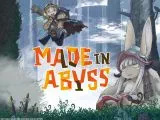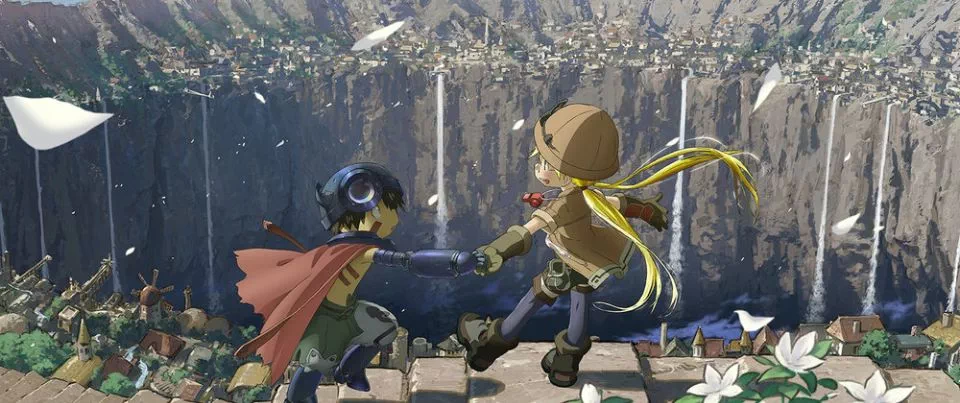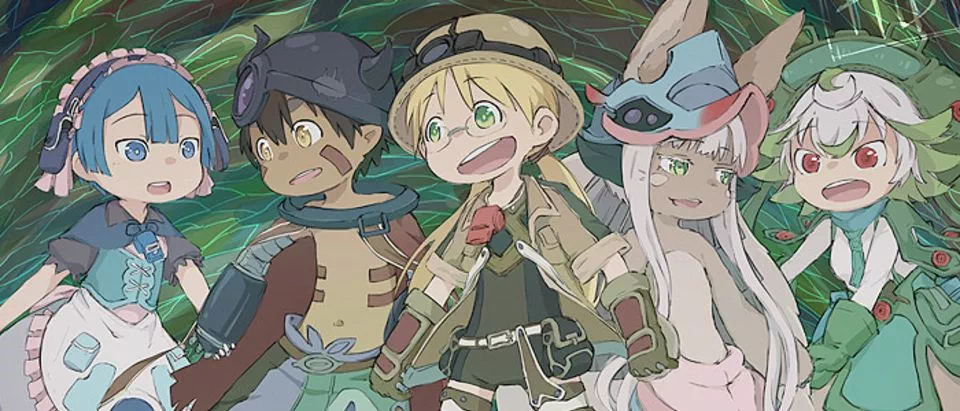Death Parade - TV Series Re...
I’d heard of Death Parade quite a bit before...
By Adonis Monahan3385

0

Introduction
Made in Abyss was produced by Kinema Citrus, the same studio that produced Black Bullet and Tate no Yuusha no Nariagari, and were originally released during the summer 2017 season. The show ran for a total of thirteen episodes and is adapted from the first volumes of the manga Made in Abyss by Tsukushi, Akihito.
The show currently holds an 8.82 out of 10 on MyAnimeList and was followed by three movies, and currently awaits a second season. I started watching Made in Abyss with high expectations; I’d seen the high ratings and heard its story and character development praised, but I was disappointed by the show itself, at least at first.
However, my feelings towards the anime, as usual, turned out to be much more complicated than they appeared to be at first, and it took me some time to unravel them into what I leave below.
Plot and World Building
If anything, Made in Abyss has done its world-building masterfully. Made in Abyss takes place in the Abyss, a massive pit extending downwards into the belly of the world. The rim of the Abyss is populated by the city of Orth, a bustling settlement full of people and, most importantly, cave raiders.
The Abyss is inherently magical and contains ancient artifacts called Relics, which cave raiders abseil into the pit to recover and sell abroad. However, Abyss is cursed. Humans can descend safely, but ascending becomes more and more perilous the deeper into the Abyss adventurers travel, with only the very strongest and most experienced cave raiders being granted permission to enter the depths, lest they lose their lives trying to ascend, or worse.
The different levels of the Abyss have their own unique challenges and Curses, varying from the gushing of blood from all bodily orifices to the loss of one’s very humanity.
We are first introduced to Riko, a young girl living in an orphanage where her mean-looking director and supervisor train the orphans to dive into the Abyss and find Relics. At around twelve years old, Riko and her companions are the lowest rank of cave raider, the Red Whistles (characterized by the red whistles they wear around their necks) and only dive a hundred or so meters below the surface.
Any deeper than that and they would be unable to return safely. The orphanage runs a tight ship, and all the orphans work hard every day to learn about the Abyss and cave raiding while returning the Relics the orphanage needs to sell to survive. One day, Riko and her friend Nat discover a partly robotic boy, or, as they called it, a collection of Relics.
The robot boy (named Reg), is soon followed by a message from the depths of the Abyss. Higher ranked cave raiders had discovered a message that had ascended to the surface by message balloon from Riko’s mother, which Riko interprets to mean that her mother is alive at the bottom of the netherworld, waiting for her.
She decides to descend all the way to the bottom, ignoring the restrictions of the orphanage and the cave raiders, to find her mother. Reg, having lost any memory of his life before being found by Riko, decides to accompany her after finding a diagram of himself in Riko’s mother Lyza’s letter.
Watching Made in Abyss for the first time, I was reminded a bit of Darling in the FranXX (at least up until the halfway point, anything further does not warrant mention or discussion) in how expansive the world was. The universe presented was consistent and had clear objectives.
I also enjoyed how the characters acknowledged the presence of other countries and territories aside from Orth, but only the Abyss mattered to them; nothing they wanted to be wasn’t in the Abyss or Orth. For the first time, the bottom of the world became a frontier for the exploration of mankind, and one semi-accessible at that.
The idea is both provoking, realistic, and interesting to the viewer. The premise is safe for the anime to grow, and interesting enough that, while borrowing from other pieces of fantasy literature, remains unique enough that it provides something new to explore.
However, despite that, the anime never really pulled me in before episode eight or nine. As I watched the show, I could feel myself acknowledging the uniqueness of the premise, and the validity of the style and progression of the plot, but I could never get myself to be invested in the characters or their plight.
The show was clearly of high quality; the animation and art alone were enough to keep me watching the show, but I just didn’t care about the characters and the plot as much as the show wanted me to. I’ll talk about this more in the section on characters, but I only really got interested when Riko and Reg began to descend in earnest.
I actually caught myself wishing the show would get darker just before it did. The introduction of Ozen, followed by the descent into the third level and the fight with the Crimson Splitjaw and the revelation of the identities of the other White Whistles is what really caught my attention.
I think the main problem was that the show was taking itself way too lightly in the beginning when the subject matter just required a serious and dark approach. Riko was way too light-hearted in the first half of the show, and the anime failed to make it clear just how dangerous the Abyss was.
Up until the turning point of the show, I was just watching passively, wondering why no one had descended into the entire Abyss before if there was no real danger besides that of ascending, and unsure of what exactly the mechanics were behind the Relics, the Whistles, descending, ascending, and even the organization of the cave raiders were.
I still don’t understand most of this, and I felt like a lot of the times the show was brushing over concepts like were the whistles come from for some kind of grand reveal later in the show, but having to rely on incomplete knowledge throughout the rest of the season just made me frustrated at my lack of understanding and predictive ability.
That’s why it was only when Reg and Riko finally made it deep into the Abyss and began to fight in earnest and face the darkness down there that I finally began to have some understanding and enjoy the adventuring happening in front of me.
 https://revyou.com/uploads/thumbnail-960/1592241684994made-in-abyss-art.webp
Made in Abyss - TV Series Review
https://revyou.com/uploads/thumbnail-960/1592241684994made-in-abyss-art.webp
Made in Abyss - TV Series Review
I’d also like to add that I’m still interested in the mystery of Riko’s mother, although there were clearly a few points where I felt like it was going to be resolved to take the show in a different, more satisfying direction, like with the Ozen’s (false) reveal and the introduction of Mitty.
Honestly, I felt like Ozen was handled a little too poorly; the way the lie was revealed seemed a bit out of character for her and most of her actions seemed erratic. Sending the Riko and Reg to train seems like a good move, but why would she do that? They were going to descend into the Abyss anyway, and the camping exercise was one purely for her to judge them worthy.
That conflict seemed a bit staged to me, and if Ozen had spoken truly about Lyza’s death, that would have made a lot more sense for the return of Lyza’s whistle (which was also rather confusing) and would have begun a great diversion point for some character motivation and some much-needed growth for Riko’s character. Still, the Mitty was another point where the story could have been resolved (at least partially).
For a moment, I thought that Mitty was the terrible, distorted form of Lyza, which would have served as a similar catalyst to Riko’s character growth, but the reality served relatively well for the continuation that the series seems to have planned.
All in all, I will say that I’m definitely interested in seeing where the plot goes from here. I can understand a little of the “longing” that the suspiciously familiar narrator keeps referencing and I do want to see just how the series plans to spin the bottom of the Abyss and the consequences of descending that far down.
However, I do feel as though it failed to successfully tie off a lot of the loose ends it formed in the early stages. The director of the orphanage is still a mystery, Mabo’s relationship to Riko is still unclear, and a lot of background details are just frustratingly unknown.
And not in a way that’s meant to make them mysterious, but in the way where manga readers can exclaim “Oh, but it was explained in the manga” that shows that the studio cut some corners in making the anime.” Still, most of this is forgotten in the wake of the descent into the Abyss and the newfound relationship between Reg and Riko.
Characters and Character Relationships
Speaking of which, Made in Abyss doesn’t exactly do an excellent job with its characters. Riko is your classical, perky female anime protagonist under the age of thirteen, and sadly there’s not much more to her than that.
Her character is very bland in the beginning, and despite her “longing” to uncover the depths of the Abyss and find her mother, I can’t help but feel like there should have been more to her character. Reg is similar but from the opposite direction.
Sometimes he feels too reserved, and at others, he’s too at ease talking to everyone he meets. The story does begin to develop both characters quite a bit as they both descend, but there’s also the issue with their relationship.
The show tries to make it seem as though they’d known each other for years and that Riko cares for Reg immensely, being incapable of descending into the depths of the Abyss without him by her side or carrying him through the unknown, but I always felt like those monologues were forced.
Yes, they’d traveled together for a period of time and stayed at the orphanage for a few weeks together, but is that enough time for Riko to love Reg so unconditionally and unreservedly? It’s only later when Riko is stabbed by the Orb Piercer that I feel Reg’s reaction is realistic, screaming when she appears to die, and trying his hardest to save her.
Still, I feel like the basic mannerisms of the characters are what need the most adjustment in Made in Abyss. Most of the communication is verbal and watching Made in Abyss made me realize just how valuable the occasional look or glance was informing the relationship between characters.
Seeing Reg enter a conversation with Nanachi with laser focus after just having laid Riko down behind him makes him seem a bit cold or forgetting of Riko, which is contrary to how he actually feels about her. Just a glance before he leaves Nanachi’s hut or the occasional look in her direction would really communicate the depths and layers in the relationships.
My final issue with the characters in Made in Abyss is really to do with a stylistic choice: nudity. Why is there? What is the point of having the characters randomly strip nude with little to no purpose whatsoever? It’s not even fanservice since Riko is definitely underage and, to put it annoyingly crudely, has nothing to service fans with.
Characters randomly discussing the state of Reg’s normal-looking genitalia is just plain distracting and often-times breaks the immersion, and the sexual innuendo in the hot-spring scene in the last episode just eliminates the innocence presented by having the main characters be two twelve-year-olds.
Art and Music
The easiest feature of Made in Abyss I can comment on by far is the art. In one word, it’s fantastic. The art style is fairly unique; I’m sure I could tell that the characters are from Made in Abyss from a mile away if I were put to the test.
The scenery is just gorgeous and brings the Abyss to life perfectly, displaying each level with its own unique characteristics, with the first level green and full of life, the second darker more mysterious, the third barren, and so on. The nether glyphs are also unique and fun to look at, while all the different monsters and creatures are a joy to look at and wonder what the inspiration for them was.
At the very least, the art’s kept me wondering about the origins of the Abyss, all the mysterious Relics within, and the fact that the mysterious structures in it look very much like the remains of an advanced, industrialized human civilization.
The music doesn’t really match the art in terms of its effect, but it still does really well and is unique while maintaining very classically fantastical overtones. Most of the music is pretty peppy, but some of the tracks do occasionally bring you into the action perfectly.
Conclusion
I finished watching Made in Abyss with a vague sense of disappointment in myself. The show is genuinely an example of high-quality anime. Its art is sharp and fresh, the premise is unique, and by the latter half of the show, it really does get quite intense and invigorating.
I only wish the characters were more dynamically portrayed and its exposition more neatly developed. All the loose ends the show left from the beginning really tickled the back of my brain as I transitioned into the rising action of the show, but I’m not going to let that stop me.
I look forward to the next season and really hope that the show maintains the better character development it started to build during the second half of the season. Doing that, and finishing or continuing the plot with a strong, decisive ending would make for a spectacular second season.
Updated 4 years ago